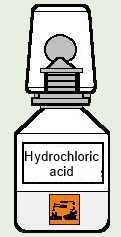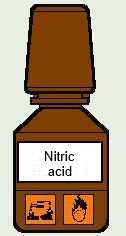






Hydrochloric acid is an aqueous solution of hydrogen chloride gas HCl. It is the main constituent of gastric acids. This acid is commonly used as reagent by industry. Hydrochloric acid is a very corrosive liquid. It must be handled with precaution. Formerly known as muriatic acid (before chlorine had been discovered and the formula HCl established), it was discovered by the alchemist Jabir ibn Hayyan (Gerber) in around 800. This chemical product has been frequently used from the beginning of chemistry. In the Middle Ages, alchemists used it in their search of the philosopher's stone (under the name of acidum salis).

During the industrial revolution, hydrochloric acid became an important industrial reagent used in numerous applications , such as the large-scale production of organic compounds such as vinyl chloride for PVC, or in the fabrication of polyurethane. Actually nearly 20 million tons are produced every year.

Sulfuric acid (formerly called oil of vitriol or vitriol) is an important chemical compound. The ethymology of the ancient name "vitriol" seems to be vitriloum, coming from vitrum ("glass"), because sulfuric acid has a glassy appearance. However the alchemists had a more fanciful dream-like definition. The acronym would originate from: Visita Interiora Terrae Rectificando Invenies Occultum Lapidem. Pure sulfuric acid pur is a viscous liquid, colourless and odourless. Some impurities result often in a yellowish colour. The reaction of sulfuric acid with water is largely exothermic : Water added with concentrated sulfuric acid may boil, exploding and projecting the liquid (like pouring water in boiling oil). Never pour water into this acid , make always the opposite to dilute it; water is less dense than the acid, so it flows above the acid. The concentrated acid reacts with water and produces enough heat to vaporize water and project the acid.

It is often yellowish due to impurities .
It carbonizes sugar, it causes burn injuries on the skin. The inhalation of sulfuric acid fog may cause long-term injuries. The atmosphere of the planet Venus holds large quantities of sulfuric acid. It is one of the main acids present in acid rain. Today sulfuric acid is the most important acid used by industry both in terms of produced quantities and diversity of applications. To processes serve to produce this acid : The contact process, the most common, and the lead chamber process. The contact process consists in oxidising de sulfur dioxide SO2 to sulfur trioxide SO3 in the presence of a catalyst . The such formed sulfur trioxide is absorbed in a sulfuric acid solution that runs off the walls of absorption towers . As soon as this solution is concentrated enough, it is collected and stored away. The lead chamber process, in its most modern version (the Petersen process) , consist in a reaction between sulfur dioxyde, water and oxygen, which combine to form sulfuric acid. This reaction is catalysed by continuously recycled nitrogen oxides . The lead chamber process, due to John Roebuck in 1746, produces a less concentrated acid containing more impurities .

Nitric acid was first synthesised at the end of the VIIIe century by the alchemist Jabir Ibn Hayyan heating saltpeter KNO3 (potassium nitrate) in the presence of copper sulfate CuSO4 and alum. In the XIIIe century, Albert the Great uses nitric acid to separate gold from silver. In the middle of the XVIIe century, Johann Rudolf Glauber obtained nitric acid distilling saltpeter with sulfuric acid, a process still used today. In the XVIIIe scentury, Antoine Lavoisier showed that nitric acid contains oxygen and nitrogen, the exact composition was determined later by Henry Cavendish. The industrial fabrication of nitric acid took only off in the XIXe century, as saltpeter and sulfuric acid were cheap and available in large volumes . In 1838, Kuhlman discovered that it is possible to obtain this acid by oxidation of ammonia in the presence of platinum. However, ammonia was too expensive until it was synthesized by the Haber-Bosch process (Fritz Haber and Carl Bosch in 1909). Wilhelm Ostwald designed the "Ostwald process" for the fabrication of nitric acid by the oxidation of ammonia and this process is still standard today. Nitric acid is a viscuous and colourless liquid ; some impurities give it often a yellowish colour. At room temperature it liberates red or yellow vapours, decomposing partially into nitrogen dioxide NO2, a reaction triggered by daylight.